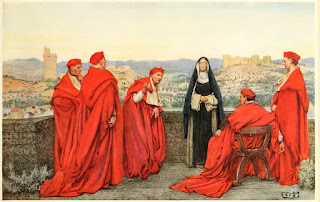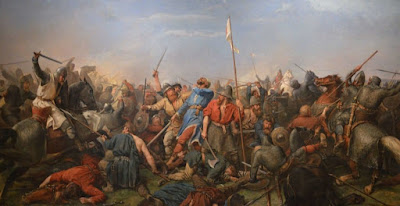First, let me say that there was more than one Eadburh. Eadburh was the name of King Alfred the Great's mother-in-law (Alfred's wife was Ealhswitha, daughter of Eadburh (830 - 895) of the Mercian royal family and Æthelred Mucel of Mercia). Then there was Eadburh of Winchester (921 - 951CE), daughter of King Edward the Elder (mentioned
here), who became a saint.
Then there was the Eadburh who was most definitely not a saint.
King Offa of Mercia and Queen Cynethryth had five children: one sone who became king of Mercia after Offa, and four girls. They married their daughter Eadburh (seen to the left) to King Beorhtric of Wessex (reigned 787 - 802) in 789.
According to Asser's Life of King Alfred, Eadburh made many enemies and demanded they be killed or exiled. Possibly jealous of anyone who was too close a confidant of Beorhtric, she (supposedly) attempted to poison one of his favorites, but wound up causing the target and her husband to be killed. Her part in the king's death being discovered, she fled to Francia and appealed for sanctuary from Charlemagne.
Asser goes on to say that Charlemagne brought out one of his young sons and asked her which she would prefer to marry. (In 802 or just after, when this would have taken place, the 55-year-old Charlemagne would have been a widower, his fourth wife Luitgard having died in 800. Still, it's a little hard to swallow.) Eadburh said she'd prefer the son because of his youth, at which Charlemagne replied: "Had you chosen me, you would have had my son; but because you have chosen my son, you will have neither him nor me."
So Charlemagne makes her an abbess in a convent, but after she is caught having a sexual affair with a Saxon, she is expelled from the convent. She dies as a penniless beggar on the streets of Pavia in Lombardy.
Let's look at this from another angle.
Eadburh, daughter of the powerful Offa of Mercia, married Beorhtric of Wessex (seen to the right). This made Wessex and Mercia allies, to the benefit mostly of Wessex. To keep Offa pleased, Beorhtric might well have given Eadburh plenty of authority. In their 13 years of marriage, however, there was no evidence of offspring. Kings need an heir (it's wise to have "an heir and a spare"), and many in Beorhtric's position would have wanted to put Eadburh away and find someone more fertile, which he did not do. We do not know when Beorhtric was born, but it does not seem likely that he died of old age when Eadburh became a widow.
So why is Asser telling this story at the beginning of a Life of King Alfred? He uses the story to explain why Wessex kings do not let their wives use the title "queen," because Eadburh's actions supposedly tainted the practice.
But wait, there's more.
As in the tragedies of Socrates, "look for the earlier crime." The alliance of Offa and Beorhtric created a power strong enough to make some significant changes in the politics of southern Great Britain. One of their acts was to drive Ecgberht (born about 771-775) into exile in the 780s, whereupon he fled to the court of Charlemagne. Who was Ecgberht? Why drive a child out of Wessex? He was the heir to the throne of Wessex, and by driving him out, Beorhtric became king. After Beorhtric's death, Ecgberht returned and ruled Wessex from 802 until 839.
So why was this important in a biography of Alfred? Because Ecgberht's son and heir was Æthelwulf, and Æthelwulf's son and heir was ... (wait for it) ... Alfred. Asser made sure to denigrate the man responsible for preventing Alfred's grandfather from taking the throne, and made a statement about how regressive Wessex was toward women at the time.
Did Eadburh poison and exile her enemies? If she did, where did she learn such behaviors? Well, the hand that rocks the cradle...
Tomorrow I'll tell you about her mother.


























